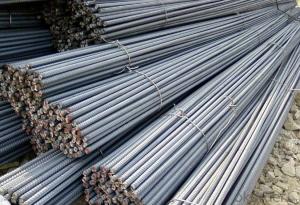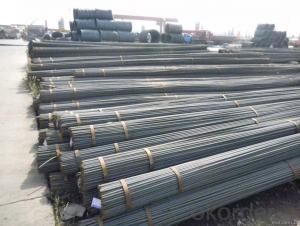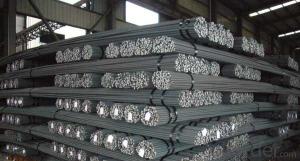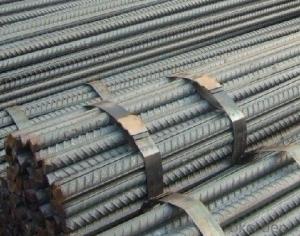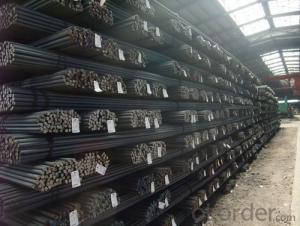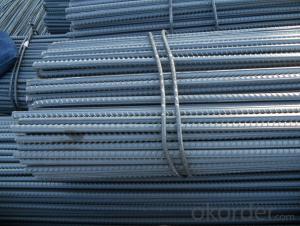GB STANDARD HIGH QUALITY HOT ROLLED STEEL REBAR
- Loading Port:
- Tianjin
- Payment Terms:
- TT OR LC
- Min Order Qty:
- 50 m.t.
- Supply Capability:
- 100000 m.t./month
OKorder Service Pledge
OKorder Financial Service
You Might Also Like
Product Description:
Specifications of Hot Rolled Steel Rebar:
The production process of Steel Rebar
1-Waling beam furnace 2-Roughing rolling group 3-Intermediate rolling train
4-Finishing rolling group 5-Water-cooling device 6-Walking beam cooler
7-Finishing equipment(including the cold scale shear,short feet collection system,
automatic counting device,bundling machine, collect bench)
Usage and Applications of Hot Rolled Steel Rebar:
Deformed bar is widely used in buildings, bridges, roads and other engineering construction. Big to highways, railways, bridges, culverts, tunnels, public facilities such as flood control, dam, small to housing construction, beam, column, wall and the foundation of the plate, deformed bar is an integral structure material. With the development of world economy and the vigorous development of infrastructure construction, real estate, the demand for deformed bar will be larger and larger..
Packaging & Delivery of Hot Rolled Steel Rebar:
Packaging Detail: products are packed in bundle and then shipped by container or bulk vessel, deformed bar is usually naked strapping delivery, when storing, please pay attention to moisture proof. The performance of rust will produce adverse effect.
Each bundle weight: 2-3MT, or as required
Payment terms: TT payment in advance or Irrevocable LC at sight.
Trade terms :FOB, CFR, CIF
Label:to be specified by customer, generally, each bundle has 1-2 labels
Note:
1. Our products are produced according to national standard (GB), if not, supply according to national standards (GB) or agreement as customer required.
2. Other Grade and Standard Deformed Steel Bar we can supply:
Grade: GR40/GR60, G460B/B500A/B500B/B500C,BST500S
Standard: ASTM, BS, DIN
The Minimum Order Quantity of these products is high, and need to be confirmed.
3. We can not only supply Deformed Steel Bar; if you need anything about building materials, please contact us for further information.
4. Please send us your detail specifications when inquire. We will reply to you as soon as possible. We sincerely hope we can establish a long stable business relationship.
- Q: Are there any standards or codes governing the use of steel rebars in construction?
- Yes, there are several standards and codes that govern the use of steel rebars in construction. These standards and codes ensure the quality, strength, and safety of steel rebars, and they help maintain consistency in their usage across different construction projects. Some commonly followed standards and codes include ASTM A615/A615M, ASTM A706/A706M, and ACI 318 Building Code Requirements for Structural Concrete.
- Q: How do steel rebars affect the durability of a concrete structure?
- Steel rebars greatly enhance the durability of a concrete structure by providing additional strength and resistance to cracking. They help to distribute loads evenly, prevent structural failure, and improve the overall structural integrity and longevity of the concrete.
- Q: How do steel rebars improve the durability of concrete structures?
- Steel rebars improve the durability of concrete structures in several ways. Firstly, steel rebars act as reinforcement in concrete, providing added strength and stability to the structure. When combined with concrete, the high tensile strength of steel rebars helps to resist cracking and prevent the structure from collapsing under heavy loads or seismic activities. Secondly, steel rebars help to control the formation and propagation of cracks in concrete structures. Concrete is strong in compression but weak in tension, meaning it tends to crack when subjected to tensile forces. By placing steel rebars strategically within the concrete, these cracks are minimized and prevented from spreading, thus enhancing the overall durability of the structure. Furthermore, steel rebars help to improve the resistance of concrete structures against corrosion. Concrete is highly alkaline, which forms a protective layer around the steel rebars, preventing them from rusting. This corrosion resistance ensures that the rebars maintain their structural integrity over time, reducing the risk of deterioration and enhancing the longevity of the concrete structure. In addition, steel rebars also enhance the fire resistance of concrete structures. Due to their high melting point, steel rebars can withstand high temperatures, thereby preventing the concrete from losing its structural integrity during a fire. This added fire resistance ensures that the concrete structure remains stable and safe in the event of a fire, further enhancing its durability. Overall, the inclusion of steel rebars in concrete structures significantly improves their durability by providing added strength, controlling cracks, enhancing corrosion resistance, and increasing fire resistance. These benefits contribute to the longevity and safety of concrete structures, making them more reliable and sustainable in the long run.
- Q: What is the elongation of steel rebars?
- The elongation of steel rebars refers to the amount of deformation or stretching that a steel rebar can undergo before it fractures or breaks. It is a measure of the ductility or flexibility of the steel rebar. Elongation is typically expressed as a percentage of the original length of the rebar. The elongation of steel rebars varies depending on the grade or type of steel used and the manufacturing processes involved. Generally, steel rebars have a relatively high elongation compared to other construction materials such as concrete or timber. This makes them suitable for applications where flexibility and resistance to deformation are important, such as in reinforced concrete structures. The elongation of steel rebars is an important factor to consider in structural design and construction. It influences the ability of a rebar to withstand loads, especially in situations where the rebar is subjected to tension or bending forces. Higher elongation values indicate a greater ability of the rebar to stretch and deform without breaking, which improves the overall performance and safety of the structure. To ensure the proper selection and use of steel rebars, it is essential to consult the relevant standards and specifications provided by regulatory bodies and industry organizations. These guidelines provide specific requirements and recommendations for the elongation of steel rebars, as well as other mechanical properties, to ensure the structural integrity of construction projects.
- Q: Can steel rebars be used in precast or prestressed concrete?
- Yes, steel rebars can be used in both precast and prestressed concrete. Rebars are commonly used in these construction methods to provide reinforcement and enhance the strength and durability of the concrete structures.
- Q: Are steel rebars suitable for use in structures with high vibration levels?
- Structures with high vibration levels commonly utilize steel rebars due to their strength and durability. This makes them suitable for such applications, as they provide stability and prevent potential damage or failure. Steel rebars possess excellent tensile strength, enabling them to withstand the dynamic forces generated by vibration. Moreover, their good ductility allows them to absorb and dissipate energy during vibrations, reducing the risk of structural damage. The performance of steel rebars in structures with high vibration levels can be further enhanced through proper design and installation techniques, including the use of appropriate reinforcement detailing. Overall, steel rebars are a dependable choice for ensuring the structural integrity and safety of buildings and infrastructure exposed to significant vibrations.
- Q: Can steel rebars be galvanized for additional protection?
- Yes, steel rebars can be galvanized for additional protection. Galvanizing is a process where a layer of zinc is applied to the surface of the steel rebar. This layer acts as a protective barrier, preventing corrosion and extending the lifespan of the rebar. Galvanized steel rebars are commonly used in construction projects where exposure to moisture, chemicals, or other corrosive elements is expected. The galvanizing process involves dipping the steel rebars into a bath of molten zinc or applying a zinc-rich coating through a hot-dip galvanizing or electroplating process. This results in a durable and corrosion-resistant coating that provides additional protection to the steel rebar, increasing its longevity and reducing maintenance requirements. Overall, galvanizing steel rebars is an effective method of enhancing their protection against corrosion and ensuring their long-term durability in various applications.
- Q: How are steel rebars protected against lightning strikes in buildings?
- Steel rebars in buildings are typically protected against lightning strikes by installing a lightning protection system, which includes lightning rods or air terminals strategically placed on the roof and connected to a network of conductors and grounding systems. This system helps to safely dissipate the electrical charge from a lightning strike, minimizing the risk of damage to the steel rebars and the overall structure.
- Q: What is the maximum spacing allowed between steel rebars in concrete slabs?
- The maximum spacing allowed between steel rebars in concrete slabs typically depends on various factors such as the thickness of the slab, the load it will bear, and the design requirements. However, as a general guideline, the maximum spacing is often specified to be around 3 times the slab thickness or 18 inches (whichever is less) to ensure proper reinforcement and structural integrity.
- Q: What is the process of welding steel rebars together?
- The process of welding steel rebars together involves heating the ends of the rebars using an electric arc or oxy-fuel flame until they reach a molten state. Once molten, the rebars are pressed together and fused to form a solid and continuous joint. This process is known as rebar welding and is commonly used in construction to reinforce concrete structures.
Send your message to us
GB STANDARD HIGH QUALITY HOT ROLLED STEEL REBAR
- Loading Port:
- Tianjin
- Payment Terms:
- TT OR LC
- Min Order Qty:
- 50 m.t.
- Supply Capability:
- 100000 m.t./month
OKorder Service Pledge
OKorder Financial Service
Similar products
Hot products
Hot Searches
Related keywords










